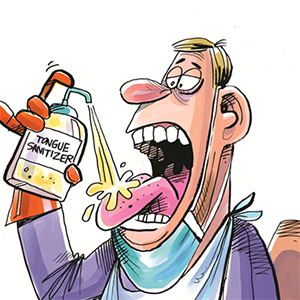Assad’s fall in Syria will further weaken Hezbollah and curtails Tehran’s ‘Iranization’ of region
Published in Political News
The fall of President Bashar Assad will not only affect the 24 million Syrians who lived – and largely suffered – under his brutal rule. Over the border in Lebanon, the impact will be felt, too.
The collapse of Assad’s government provides another blow to its Lebanese ally, Hezbollah, which was already reeling from an Israel conflict that weakened its capabilities and decimated its leadership. But many others in Lebanon will be rejoicing, not least the 1.5 million refugees who fled Syria to escape Assad and a 13-year civil war.
As an expert on Lebanese history and culture, I believe the ripple effects from Syria are to be expected. The two countries’ modern histories are intertwined, and throughout its 54-year rule, the Assad family has intervened in Lebanon many times – mostly to the detriment of its people, its economy and its stability.
Since its formation in the early 1980s, Hezbollah has benefited from strong support from the Syrian regime. There were moments of tension between the two, for sure – notably in the midst of the Lebanese civil war. But overall, Hezbollah has been able to rely on Syria for arms, training and easy land access to Iran.
And this arrangement was reciprocal. When Assad’s rule was challenged in 2011 and the country descended into civil war, Hezbollah fighters crossed into Syria to bolster government troops.
But having grown to become the most powerful paramilitary entity in Lebanon, Hezbollah has seen its fortunes suffer of late. The recent war with Israel severely weakened the group and forced it into accepting a ceasefire deal that includes a pathway toward disarmament.
Furthermore, Lebanese support for Hezbollah has shifted dramatically, with open calls for the group to cease its paramilitary activities. The group’s war with Israel cost the lives of about 3,700 people in Lebanon, and about 1.2 million Lebanese – about one-fifth of the population – were internally displaced from their homes. Meanwhile, the economic loss for Lebanon is estimated in the billions of dollars.
It is no coincidence that the recent rebel advance that led to Assad’s ouster began the same day the Israel-Hezbollah ceasefire was signed. Hezbollah forces were depleted, and many of their fighters were pulled out of Syria to reinforce Lebanon’s southern border.
Syrian rebels chose this moment to strike, knowing that Iran was also stretched too thin with the Israel-Hezbollah war to come to Assad’s aid.
The domino effect has resulted in the unraveling of Iran’s “axis of resistance.” Certainly, Tehran has lost its firm grip over Syria and Lebanon.
The fact that the fall of Assad coincides with the potential end of both Syria’s civil war and the Iran-Syria-Hezbollah alliance is fitting; it was the start of the civil war that helped anchor that three-way relationship in the first place.
In 2011, the Arab Spring – a series of pro-democracy and human rights protests that started in Tunisia – reached Syria. Anti-Assad protests broke out in Daraa and soon spread to major cities such as Homs, Hama and the capital, Damascus.
The Syrian government responded with brutality, ordering soldiers to fire at the protesters, while detaining and torturing thousands of men and boys.
International outcry followed. But the Syrian government remained in power with the support of Iran and Hezbollah. In fact, in addition to Hezbollah’s fighters, Iran’s Revolutionary Guard Corps was also advising Assad and fighting alongside his military against the Syrian people.
For Tehran and its proxy Hezbollah, this helped further the “Iranization” of the region – that is, the spread of the ideology of the Iranian revolution and the conversion of Syria and Lebanon into Shia states.
Syria is predominantly Sunni Muslim. Under the Assad family, it was ruled by an Alawite minority – a group that practices a branch of Shia Islam. Hezbollah, as a Shia terrorist group, swore allegiance to Iran’s supreme leader in its 1985 manifesto.
The Palestinian cause was another unifying factor between the three. The post-1979 revolutionary Iran credo of “death to Israel” is a sentiment shared by the Assad regime and Hezbollah fighters. However, Assad may have been less vocal about it – especially as he attempted to negotiate with Israel over the occupied Golan Heights.
Assad’s Syria, Iran and Hezbollah were not just unified by radicalism and their desire to govern the region. They also shared economic interests and have benefited from trafficking illegal drugs, notably Captagon, an amphetamine-type stimulant that is mass-produced in Syria under the patronage of Assad and Iran. The drug provided an alternative and substantial source of revenue at a time when international sanctions were biting.
With the help of Hezbollah and its control of Lebanon’s airport and seaports, the drug has become widely available in the Gulf states. Its highly addictive nature posed a real threat in the Arab world, and Assad used it to pressure Saudi Arabia into advocating for the reinstating of Syria’s membership in the Arab League in 2023. In return, the Syrian regime agreed to redirect its drug trafficking elsewhere.
With Hezbollah’s defeat in Lebanon and the fall of the Syrian regime, the “Iranization” of the region is, at the very least, stalled.
Nevertheless, 54 years of Assad family rule in Syria has left a long trail of destruction in neighboring Lebanon.
In June 1976, Syria sent more than 25,000 soldiers over the border to put an end to the Lebanese civil war. Its presence was supposed to be temporary, but it was extended for over four decades.
By the time the Lebanese civil war ended in 1991, Syria was exercising total control over Lebanon’s territory as well as its domestic and international affairs. Serious human rights violations were reported, including disappearances, illegal detentions, torture and the assassinations of political figures and journalists.
In February 2005, Lebanese Prime Minister Rafik Hariri – who publicly opposed the Syrian hegemony in Lebanon – was assassinated in an attack in which Assad and senior Syrian officals have been heavily implicated.
The killing sparked the Cedar Revolution, when hundreds of thousands of Lebanese citizens took to the streets demanding the immediate departure of the Syrian forces.
Although Syrian forces left Lebanon, the Syrian regime continued to interfere in the country’s politics through Hezbollah, which evolved into a political-military organization and entered the government in 2008.
From that point onward, Hezbollah would block any decision that did not serve Syria’s and Iran’s interests. For instance, Hezbollah and its allies vetoed any presidential candidate who was not supportive of the Syrian regime – a policy that plunged Lebanon into a prolonged presidential vacuum.
While Hezbollah may continue to operate within Lebanon and under Iran’s umbrella, Assad’s fall means it is deprived of its supply route.
Without Syria, Hezbollah has no quick access to Iran’s fighters and weapons – and the newly signed ceasefire between Lebanon and Israel reaffirms Lebanon’s commitment to a U.N. resolution calling for Hezbollah’s disarmament.
And while it is unclear what the new Syria will look like, for this moment at least, Lebanon’s and Syria’s populations – both of whom have suffered under decades of brutal rule and Hezbollah’s abuse – are able to rejoice at the departure of the man responsible for inflicting so much of the pain.
This article is republished from The Conversation, a nonprofit, independent news organization bringing you facts and trustworthy analysis to help you make sense of our complex world. It was written by: Mireille Rebeiz, Dickinson College
Read more:
Abu Mohammed al-Golani may become the face of post-Assad Syria – but who is he and why does he have M US bounty on his head?
Syrians, in a triumph of hope, turn the page on the horrors of Assad
Assad leaves behind a fragmented nation – stabilizing Syria will be a major challenge for fractured opposition and external backers
Mireille Rebeiz is affiliated with American Red Cross.





























































Comments